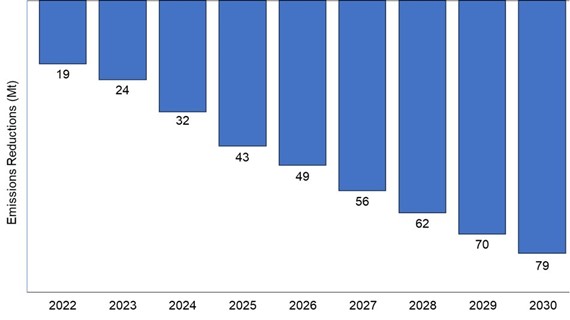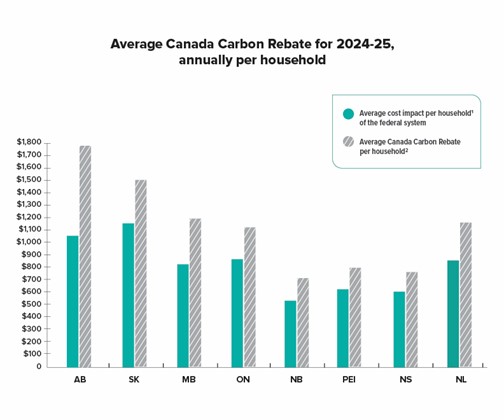Every day, we see the increasing impacts of climate change and they're costing Canadians more and more.
A price on pollution is widely recognized as the most efficient means to reduce the greenhouse gas emissions that are contributing to the more intense wildfires, droughts, and floods caused by climate change. Canada's approach to pollution pricing is also designed to put money back in people's pockets.
Putting a price on pollution is a cornerstone of Canada's plan to tackle climate change. It's designed from the ground up to support households and the economy and works by encouraging businesses and consumers to choose less carbon-intensive options for energy production, home heating, and transportation.
Canada's approach to carbon pollution pricing lets provinces and territories put their own system in place, as long as it meets national minimum stringency standards. Where a province or territory does not price pollution, or if they request the federal system, the federal backstop system is applied.
The federal backstop pollution pricing system is revenue neutral for the Government of Canada, with all direct proceeds returned in the jurisdiction in which they were collected. In provinces where the federal fuel charge applies, the majority of proceeds are returned directly to Canadians through quarterly Canada Carbon Rebate payments. Because each household of the same size received the same rebate, for eight out of ten households, these rebate payments are higher than the amount of fuel charge they pay.
Estimates show that pollution pricing contributes roughly one-third of the greenhouse gas emissions reductions achieved by Canada's Emissions Reduction Plan in 2030.
To achieve these emissions reductions in the absence of carbon pricing would come at a significant additional cost to the Canadian economy. Canada's Ecofiscal Commission shows pollution pricing delivers the lowest-cost emissions reductions compared to other policy options.
Pollution pricing harnesses the power of the market-the collective knowledge and decision-making of every household, business, and organization. While other tools like regulations and incentives have an important role to play in Canada's climate plan, without carbon pricing any climate plan will be more expensive and will miss opportunities for innovation.
Carbon pollution pricing will contribute as much as one-third of Canada's emissions reductions in 2030

Long description
| Year | Emissions reductions (Mt) |
|---|---|
| 2022 | 19 |
| 2023 | 24 |
| 2024 | 32 |
| 2025 | 43 |
| 2026 | 49 |
| 2027 | 56 |
| 2028 | 62 |
| 2029 | 70 |
| 2030 | 79 |
Estimated contribution of carbon pricing to reductions achieved under the 'With Additional Measures' scenario as published in Canada's Fifth Biennial Report on Climate Change.
Carbon pricing and Canada's Emissions Reduction Plan are helping Canadians save money
As Canadians continue to take actions to reduce emissions-by improving their home insulation, using transit, purchasing an electric vehicle, or installing a heat pump-they will cut costs and save money.
Clean Energy Canada has shown that a Canadian family that adopts clean-energy solutions, including electric vehicles and heat pumps, could reduce their monthly energy bills by $800, compared to a household that is largely reliant on fossil fuels.
Canada's approach to carbon pricing does not create inflation or increase the cost of living. In fact, the federal government is focused on addressing the cost-of-living crisis and is delivering the Canada Carbon Rebate to make life affordable for Canadians and support families. The pay-in-advance Canada Carbon Rebate, distributed via direct bank deposit or cheque, outweighs the carbon costs for the vast majority of families in provinces where the federal fuel charge applies.
For 2024-2025, a family of four will receive the following in base Canada Carbon Rebate amounts: $1,800 in Alberta ($450 each quarter); $1,504 in Saskatchewan ($376 each quarter); $1,200 in Manitoba ($300 each quarter); $1,120 in Ontario ($280 each quarter); $760 in New Brunswick ($190 each quarter); $824 in Nova Scotia ($206 each quarter); $880 in Prince Edward Island ($220 each quarter); and $1,192 in Newfoundland and Labrador ($298 each quarter).
This year's Canada Carbon Rebate amounts reflect the temporary pause of the fuel charge on deliveries of home heating oil that came into effect on November 9, 2023. In Nova Scotia, Prince Edward Island, and Newfoundland and Labrador-where households more often rely on home heating oil- rebate amounts have been adjusted to reflect expected fuel charge proceeds in 2024-2025, compared to 2023-2024. In all other provinces where the federal fuel charge applies (Alberta, Saskatchewan, Manitoba, Ontario, and New Brunswick), Canada Carbon Rebate amounts have increased.
In addition to the base Canada Carbon Rebate amount, a rural supplement is provided to residents of small and rural communities. To further recognize rural Canadians' higher energy needs and more limited access to cleaner transportation options, the government has introduced legislation to double the rural supplement available for households in rural areas and smaller communities from 10 percent to 20 percent of their Canada Carbon Rebate base amount, which would be delivered following Royal Assent of Bill C-59.

Long description
| Province | Average cost impact per household of the federal system | Average Canada Carbon Rebate per household |
|---|---|---|
| Alberta | 1 056 $ | 1 779 $ |
| Saskatchewan | 1 156 $ | 1 505 $ |
| Manitoba | 828 $ | 1 193 $ |
| Ontario | 869 $ | 1 124 $ |
| Nouveau-Brunswick | 536 $ | 719 $ |
| Île-du-Prince-Édouard | 628 $ | 801 $ |
| Nouvelle‑Écosse | 609 $ | 766 $ |
| Terre-Neuve-et-Labrador | 859 $ | 1 162 $ |
Source: Department of Finance Canada calculations using inputs from Environment and Climate Change Canada, Canada Revenue Agency, and Statistics Canada.
Notes:
1 The estimated average impact per household reflects the impact on household spending costs, accounting for direct impacts (reflecting consumption of fuels to which the federal carbon pollution pricing system applies) and indirect impacts (reflecting consumption of goods and services with federal carbon pollution pricing embedded in them). These impacts are inclusive of carbon pollution pricing embedded in imports that households purchase from other provinces and territories on which a federal carbon pollution price is applied. They do not include the costs associated with other carbon pricing systems; accordingly, they do not include the costs associated with the provincial systems for large industrial facilities. Estimates also assume full pass-through from businesses to consumers.
2 The 2024-2025 Canada Carbon Rebate amounts include prior-year adjustments made with respect to proceeds generated in previous years in Alberta, Saskatchewan, Manitoba, and Ontario. As a result, the average payment amount per household in these provinces also reflects this adjustment. The Canada Carbon Rebate amounts also reflect the proposed doubling of the rural top-up rate from 10 percent to 20 percent.
Helping Canadians reduce emissions and save money
With the transportation sector responsible for a quarter of emissions in Canada, helping Canadians switch to electric vehicles is one of the most impactful things we can do for our climate efforts.
The Government is providing funding to build 50,000 more charging stations across the country, toward the goal of almost 85,000 publicly funded chargers across Canada by 2027. In addition, the Government's incentive program is making electric vehicles more affordable by providing point-of-sale incentives of up to $5,000 toward the purchase of a new, eligible zero-emission vehicle. To date, this has helped over 300,000 Canadians make the switch.
The Canada Greener Homes Grant has offered homeowners grants up to $5,000, as well as interest-free loans for cost-saving and energy-efficient retrofits, such as windows, doors, heating systems, solar installations, and more. The next phase of the Canada Greener Homes Initiative will complement the suite of federal government initiatives available to Canadians to upgrade their homes and reduce their bills.
Industrial pollution pricing system
The federal backstop carbon pollution pricing system has two parts: a regulatory charge on fossil fuels, like gasoline and natural gas (the "fuel charge"), and a pollution pricing system for heavy industries, known as the Output-Based Pricing System. Most provinces and territories with their own industrial carbon pricing systems also use the Output-Based Pricing System model, while Quebec and the Northwest Territories each have their own approach for pricing industrial emissions.
All industrial pollution pricing systems are designed to ensure there is a price incentive for industrial emitters to reduce their greenhouse gas emissions and spur innovation while maintaining competitiveness. Not only does industrial pollution pricing ensure big polluters pay their fair share, it is also helping Canada attract new major projects that are creating good‑paying jobs.
Canada's approach to industrial pricing gives major heavy industries certainty on the price they must pay for the pollution they generate. This helps them make informed decisions on re‑investing in cleaner operations. It is also designed to protect against the risk of industrial facilities moving from one region to another to avoid paying a price on carbon pollution.
All revenues that are generated from the federal industrial pollution pricing system in backstop jurisdictions are returned in the jurisdiction of origin to support industrial projects to cut emissions and use new, cleaner technologies and processes.
Currently, the federal pollution pricing system for industry applies in Prince Edward Island, Manitoba, the Yukon, and Nunavut. All other provinces and territories are implementing their own pricing systems for industrial emitters, aligned with the federal benchmark.
Pollution pricing in the agriculture sector
Farmers are on the frontlines of climate change, facing ever-increasing risks of floods, droughts, and storms to their operations. Canada's approach to pollution pricing was designed to take into account the unique needs of farmers. Farmers do not pay the fuel charge for gasoline and light fuel oil (diesel) used in eligible farming machinery on farms. Similarly, biological emissions are not priced under the federal system, such that roughly 97 percent of on-farm emissions are not subject to the price on pollution.
Greenhouse operators also receive upfront relief of 80 percent of the fuel charge on propane and marketable natural gas used to heat an eligible greenhouse or to supplement carbon dioxide in eligible greenhouses in order to grow or produce plants.
Additionally, farm businesses that operate in provinces where the federal fuel charge is in place can generally receive a refundable tax credit, the purpose of which is to return total fuel charge proceeds related to farm use of natural gas and propane in heating and drying activities in those provinces, to help farmers transition to lower-carbon ways of farming.
As part of the strengthened climate plan and the 2030 Emissions Reduction Plan, the Government of Canada committed over $1.5 billion to accelerate the agricultural sector's progress on reducing emissions, while remaining a global leader in sustainable agriculture. This includes $470.7 million for the Agricultural Clean Technology (ACT) Program to create an enabling environment for the development and adoption of clean technology that will help drive the changes required to achieve a low-carbon economy and promote sustainable growth in Canada's agriculture and agri-food sector.






